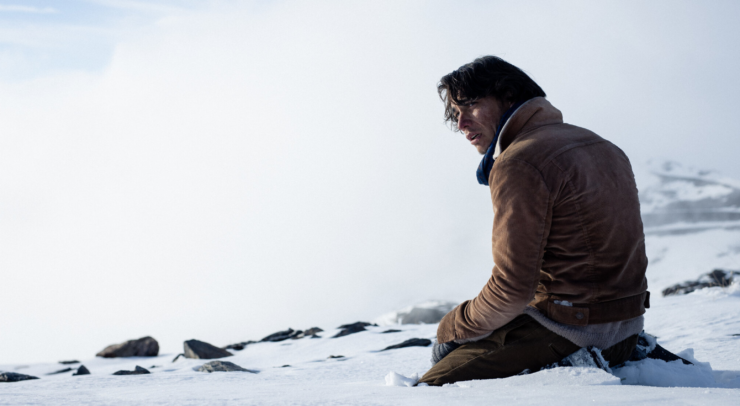“What happens when the world deserts you?”
“What happens when the world deserts you?” is one of the first lines spoken by Numa Turcatti (Enzo Vogrincic) in The Society of the Snow (2023, La sociedad de la nieve in Spanish), directed by Spanish filmmaker J.A. Bayona.
Inspired by Pablo Vierci’s 2009 book of the same name, the film recounts the true story of an Uruguayan rugby team, whose plane headed for Santiago, Chile crashes into the unforgiving heart of the Andes mountains in 1972. Some of the survivors of the traumatic event were highly involved in the film’s production and even had cameos.
Now an Oscar contender (best international feature, and best makeup and hairstyling), it has become one of Netflix’s biggest non-English movie hits ever.
The film’s opening sequences introduce us to carefree, smiling characters bathed in golden sunlight. A boyish sense of adventure and mischievousness pass through the rugby team as they bid their families goodbye and board the plane; they are on their way to an exciting game in Chile. Everything seems to be moving smoothly, but an impending sense of doom settles as the small plane begins to experience turbulence above the unforgiving jaws of the Andes.
At first, the rugby team takes it lightly and laughs it off, taking their time to get seated and buckle their seatbelts. It isn’t until the plane takes a dive and one of them is violently hurled to the ceiling that panic takes over.
Numa, the protagonist (Vogrincic), gazes apprehensively out the window as the snowy mountains of the Andes loom too close for comfort. We get a view through the cockpit windshield and are lulled into a false sense of security.
Right as we think we’ve dodged a bullet, we’re jarred by the plane’s ruthless crash into the pristine landscape; the wings are ripped right off as the plane ricochets along the snowy cliffs. Unsecured luggage is vomited from the overhead shelves and the back of the plane is savagely torn away, sucking passengers still strapped to their seats and suitcases alike into the white abyss. A stomach-churning symphony of metal crumpling and human bones snapping swells as the plane is crushed like a discarded soda can, suffocating the passengers trapped inside.
Of the 45 passengers, only 29 survived the initial crash. Despair, anguish, and fear reign as the survivors realize who’s missing, and discover the mangled bodies of their loved ones.
The rumble of planes searching for the fallen aircraft and its passengers echo throughout the mountains for a few days; the team is hopeful that they will be rescued. However, it soon becomes terribly clear that the world has given up and abandoned them.
Upon this crushing realization, a harrowing physical and psychological battle ensues. The will to live tips the scales against moral and ethical values as the survivors reluctantly turn to the only source of nourishment they have after exhausting their meagre food supply…the bodies of the dead.
It is a decision that is painstakingly considered from all angles and categorically resisted by some. Is it possible to eat your loved ones, even if it’s a question of life or death?
The effects of the extreme cold and the churning snow are terrifying – characters lose teeth, go blind, and develop painful sores and infections. Their skin grows shrivelled and discoloured.
The cinematography was exceptional. The movie was shot across two continents, with filming locations in Spain, Uruguay, Chile, and Argentina, as well as the site of the original plane crash in the Andes.
It showcased the breathtaking beauty of the mountains, but also underlined how painfully barren and desert-like the unforgiving landscape is. There were many shots that emphasized how invisible the white plane’s corpse was in the snow, which explains why the search planes couldn’t spot them. The men are like ants, dwarfed by the crippling immensity of the peaks.
The use of music was also very deliberate. The score features stirring, heartbeat-like instrumentals. There were also long stretches where there wasn’t any music at all, just the characters’ ragged breathing as they fought against the paralyzing cold. The silence as they attempt to explore their surroundings is deafening. We’re right there with them.
As the driving force behind the survival effort, Numa refuses to give up hope throughout the film. He declines to eat human flesh until it’s physically impossible to go on without food and visibly struggles to accept when the others resort to cannibalism. There’s a wonderful bit of acting where his eyes shift as the realization that his friend will partake in the grisly activity dawns on him.
Numa is the embodiment of the will to live and to experience all the wonders and everyday beauty of the world. He puts into perspective everything we take for granted – time spent with family, food, dancing, laughing, and the strength to simply cry. All of these luxuries were ruthlessly ripped away from him, and there’s absolutely nothing he can do about it.
His monologue was painful to watch – his face was gaunt and his cheeks sallow, his once perfect skin and teeth marred by the merciless cold. His lips were chapped and peeling and his eyes were dark pools of anguish. In fact, Vogrincic lost 23 kilos during filming for the role.
The film draws inspiration from photos taken in 1972 and recreates them with chilling accuracy.
The entire cast did a phenomenal job capturing the breadth of emotions their real-life counterparts must have felt – their desperation and fear, as well as their joy over small triumphs. The film was shot chronologically, and actors followed strict diets and exercise regimes in order to shed weight to reflect their harsh living conditions.
They filmed for 120 days in the bitter cold of the snowy mountains, in isolated locations far from home; according to Vogrincic, this helped to make their acting feel more natural. The film’s behind-the-scenes documentary (Netflix) reveals that some had never even seen snow before filming the movie.
The documentary also offers a glimpse into the arduous process necessary to craft the sets and to prepare the actors for filming the emotionally and physically taxing sequences, one of the most impressive being the initial crash and their struggles in the snow. They had to practice portraying intense physical pain and clawing their way out of snowdrifts (both real and artificial), and cables were used to violently yank actors into the air to simulate the relentless wind. The attention to detail is extraordinary and completely immerses the audience in the action.
In conclusion, Society of the Snow is very difficult to take in, due to the graphic depictions of cannibalism and death. The entire cast and crew successfully pull us in alongside the characters with outstanding visual effects and set designs to live the torturous experience with them.
A remarkable true story of survival, bravery, friendship, and resilience worthy of the highest distinction. It’s a poignant reminder to appreciate everything we take for granted, and an admirable tribute to all those involved in the real-life crash.
A cinematic masterpiece.





